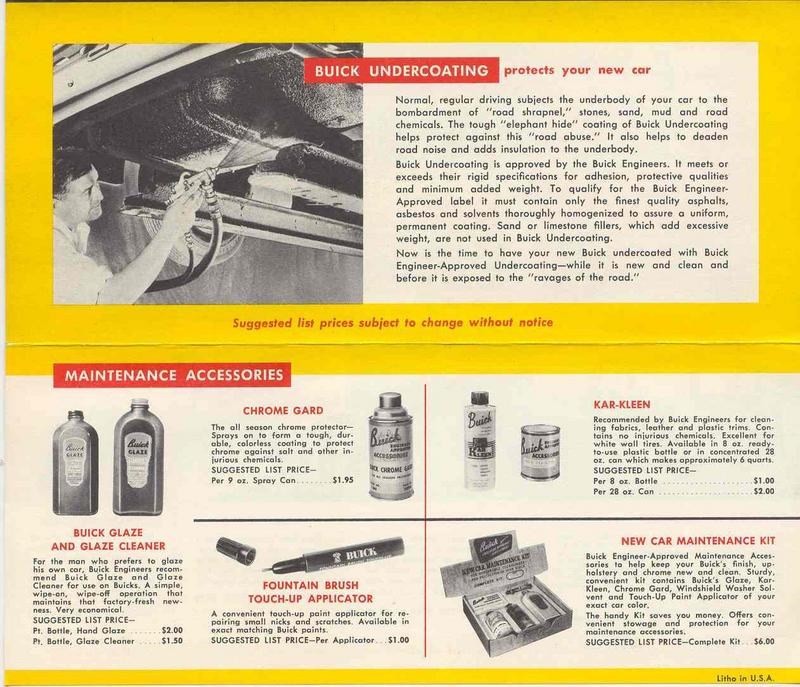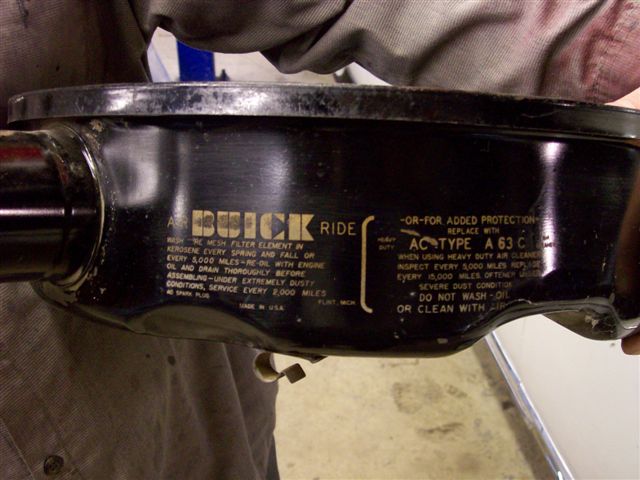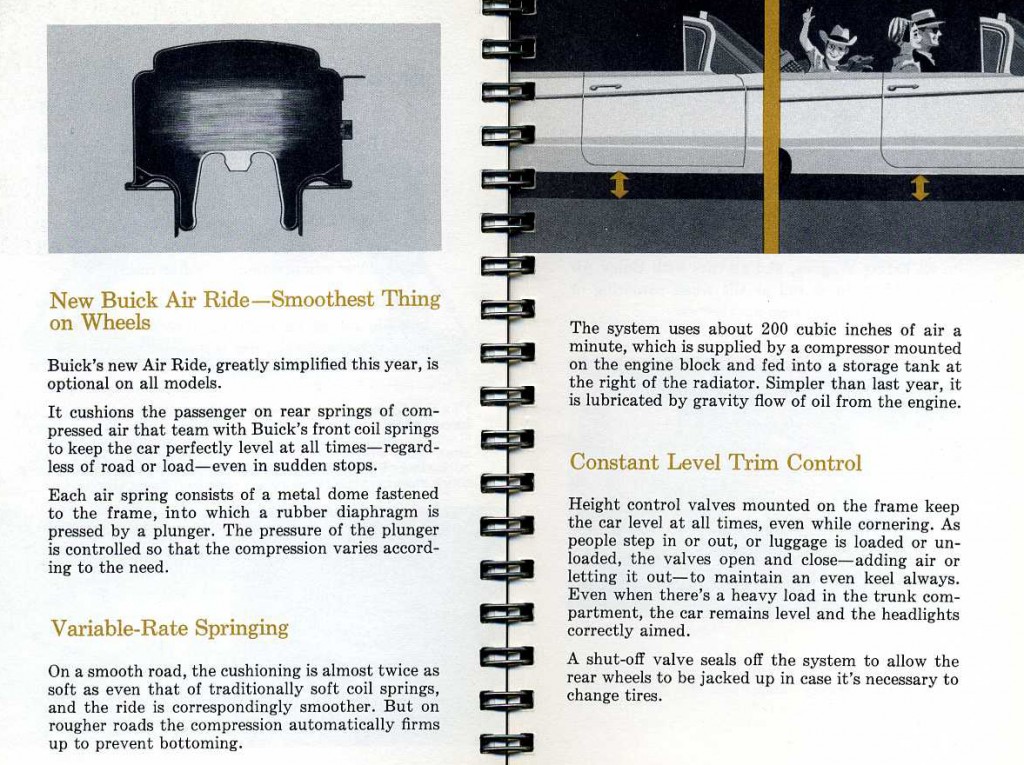Further disassembly of the car has revealed that although the car currently has a standard twin turbine transmission installed, the car came from the factory with the optional Triple Turbine transmission.
The Triple Turbine transmission, abbreviated as “3T” in some reference manuals, is considered the “ultimate dynaflow” by many Buick enthusiasts. Buick produced several versions of the Dynaflow transmission from 1948 to 1963. Unlike most modern transmissions which utilize mechanical gears and clutches to produce torque to get power to the wheels, the Dynaflow operates on an entirely different principle. Rather than a mechanical connection, the Dynaflow essentially operates on spinning oil. In the most simplistic analogy, think of two fans facing each other inches apart. Turning on only one fan will cause the other fan to spin simply because of the air being forced through its blades. Imagine these two fans submerged in oil and you’ll understand the basic principle behind the Dynaflow transmission. While the driver of a car with a mechanical transmission can hear and feel each shift point, the driver of a Dynaflow cannot hear or feel any shifting, just incredibly smooth and silent acceleration.
Although Dynaflows were extremely smooth, especially when compared to other transmissions of their day, they also developed a reputation for being relatively slow and inefficient because of its initial design. Buick improved the Dynaflow in 1953 by incorporating two turbines. Named the “Twin Turbine Dynaflow,” this new design resulted in a higher level of performance and greater efficiency. In 1955 Buick further improved the design by incorporating variable-pitch stators for improved flexibility. Instead of being fixed, stator blade angles were varied through a mechanical linkage corresponding to throttle position to generate extra torque. The more acute the blade angle, the greater the torque multiplication.
Continuing its refinement of the design, Buick invested a reported $86 million in tooling to produce one last version of the Dynaflow. Introduced in 1958, the “Flight Pitch Dynaflow” was standard equipment on the Roadmaster 75 and Limited, and optional on all other 58’s. This transmission utilized three turbines to further increase torque output. One of the unique features of this transmission was the lack of a “Low Gear” (L) position that could be selected by the operator, and the addition of a “Grade Retard” (G) position to be used only for engine braking on long or steep declines.
This Grade Retard (G) position was a complex but useful feature because on long or steep declines the lack of a direct mechanical connection between engine and drive wheels resulted in a greater tendency for the car to “get away” from the driver unless the brakes were engaged. Unfortunately, because many Buick owners had become accustomed to engaging low gear for faster take-offs with their previous Dynaflows, they attempted to use the new Grade Retard feature for this same purpose with disastrous results. This improper operation, in combination with several design flaws, led to the early failure of many Flight Pitch transmissions.
Buick engineers were able to resolve many flaws with several internal enhancements and reintroduced the transmission in 1959 renamed the “Triple Turbine” (the word “Dynaflow” was dropped). While not standard on any model, this transmission was an available option on all 59 Buicks. The engineering improvements made the 1959 Triple Turbine the most refined Dynaflow ever produced. Coupled to a lower final drive ratio, 2.78:1 with the Triple versus 3.07:1 with the Twin, it offered superior starting acceleration and greater efficiency. Sales material for the 1959 Buick stated, “The Triple Turbine adds extra get-up-and-go to give you the ultimate in power performance. The stator, with its infinite pitch stator blades that change angle automatically at your command, promises a new driving thrill.” Cars equipped with this option can be identified by looking at the shift quadrant lens on the dash. The shift quadrant sequence on the Triple Turbine reads P-R-N-D-G (where “G” stands for Grade Retard) whereas the Twin Turbine sequence reads P-N-D-L-R. The below pic shows the original 3T dash quadrant plate (left) which was installed in my car from the factory, along with the standard 2T plate that was in the glovebox presumably to be switched out, but never was.

Despite the improvements over the Twin Turbine, the Triple Turbine never caught on with the public. Due in part to its extra cost ($275 for LeSabre and $70 on all other Models), the poor reputation from the 1958 version, and continued failures based on improper operation (driving in the Grade Retard position), Buick discontinued the transmission at the end of 1959. Because relatively few were made, and further because it was far more complex than a Twin Turbine, few transmission shops were willing or qualified to rebuild them as they eventually required service. As a result, many of the Triple Turbine equipped cars were converted to Twin Turbine over the years. Buick continued equipping its cars with Twin Turbines through 1963.
Because the Triple Turbine offered faster acceleration, improved fuel economy, unparalleled smoothness, and the unique grade retard feature to keep speed in check on long declines, it is considered the absolute pinnacle of Dynaflow evolution.
Below are pages from the actual 1959 Buick Facts Book describing the operation of the optional triple turbine and standard twin turbine transmissions (Click on the next three Picture to Enlarge).
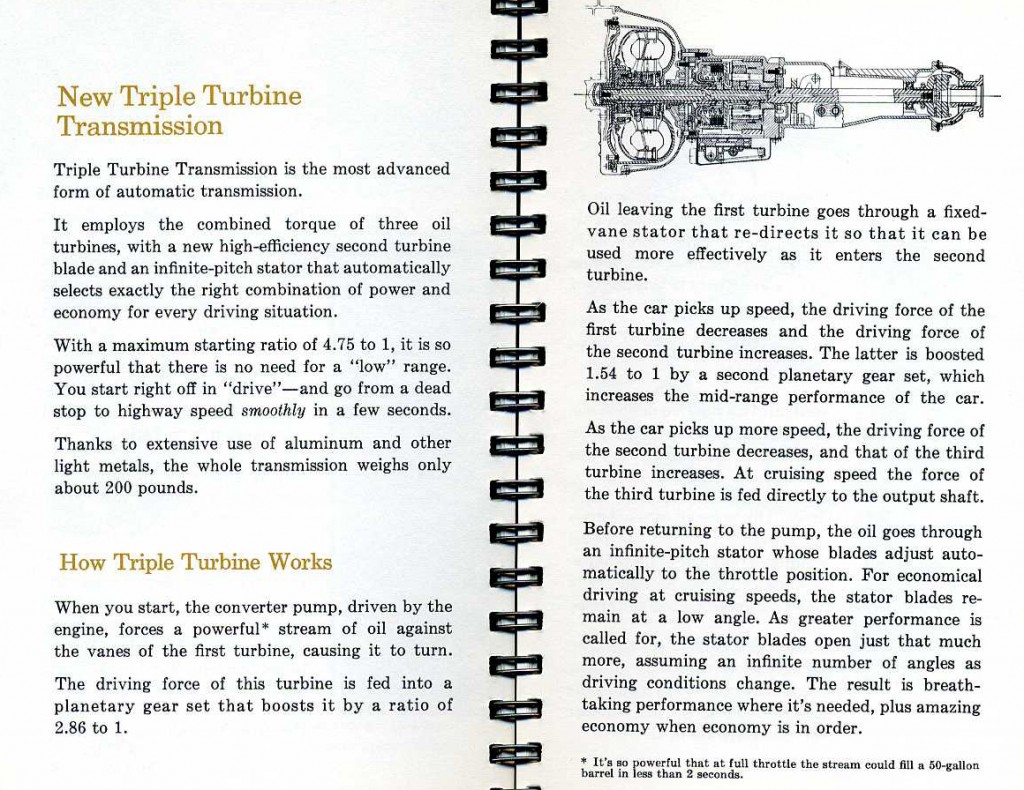
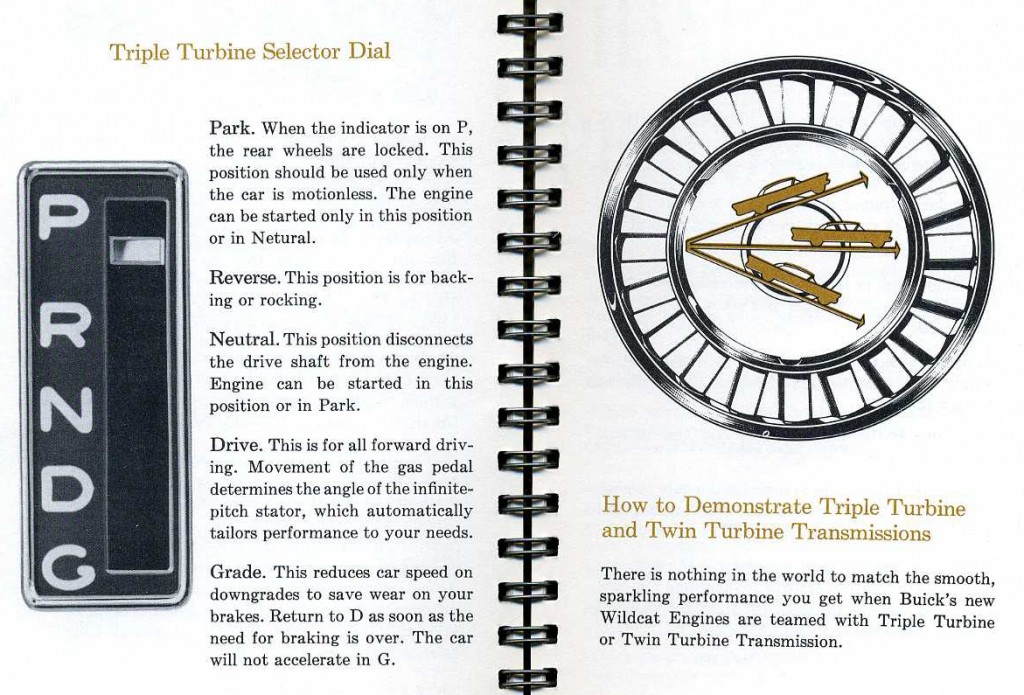
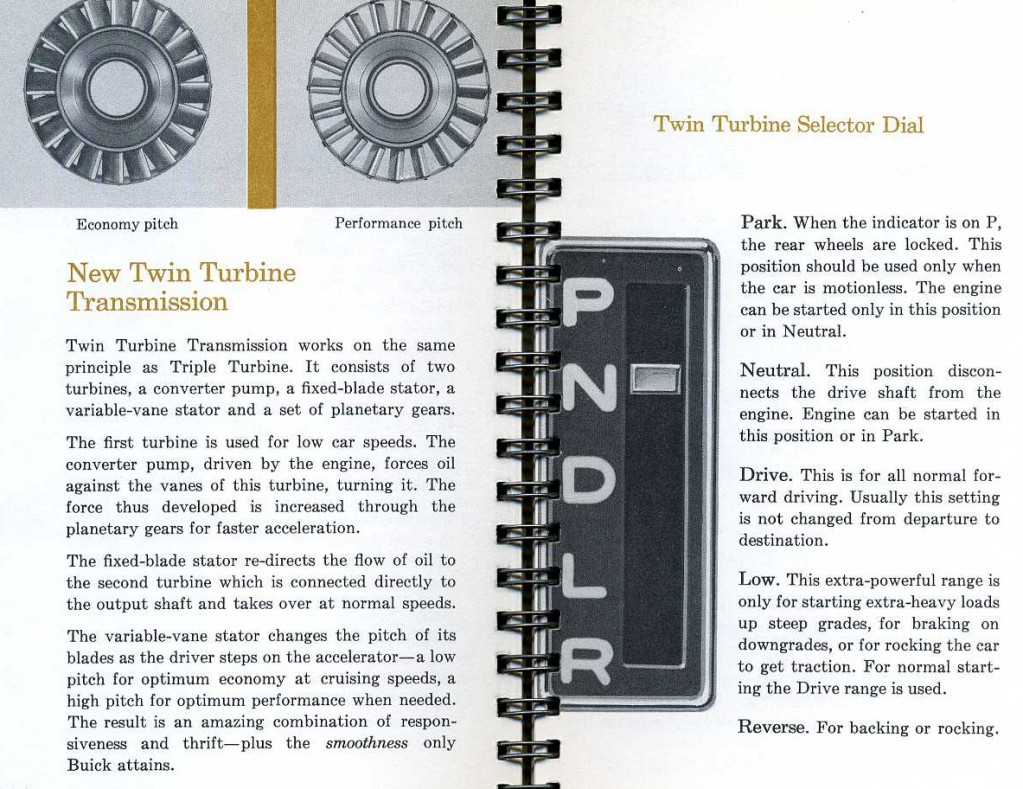
After learning my car was originally equipped with the Triple Turbine, my plan was to locate, rebuild, and reinstall one back into the car. I went so far as to buy an entire rolling chassis with a Triple Turbine in the hopes of using it, but in the end I had to decide against it. The bottom line was that there was simply too much cost and uncertainty involved with trying to rebuild it.
Here are the reasons I abandoned switching back to the Triple Turbine…
I contacted Fatsco’s (http://www.fatsco.com/) one of best antique transmission shops here in NJ (they also own a large nationwide transmission parts distribution business) and they told me they wouldn’t touch it. Instead the old guy who owns the place told me about the numerous times he’s replaced 3T’s with the standard Twin Turbine (2T) Transmissions on 59 Buicks in his shop simply because of the complexity and lack of parts availability for the 3T.
I also had Greg talk to his guy that has been rebuilding the transmissions in his show cars for a hundred years…bottom line…he’d done a few 3T’s many, many years ago…but wasn’t keen on doing another (he’ll do the twins any day of the week).
I contacted and spoke with Moses Ludel in Nevada (775-463-5965), the world famous master transmission rebuilder and he told me no problem rebuilding it and that he’d done a few. He said that he would rebuild it back to factory specs “even if it didn’t come that way from the factory” (which he claimed was one of the problems). Only downside… paying over $5,000 for the rebuild (not including crating and shipping clear across the country).
I spoke with Jim Hughes of Ohio (419-874-2393) who was a super nice guy and he told me he rebuilds many of them each year, and sometimes even has a rebuilt one on the shelf (but he doesn’t right then) and that he ships out same day when he has one and asks that you ship back the core in the same crate. The price was even relatively reasonable compared to Ludel. Downside…it still cost twice as much as rebuilding a twin, and if I ran into a problem down the road there is nobody around here to fix it so I would have to bring it somewhere… have it dropped, crated and shipped back to Ohio.
I talked with Lamar Wilkins at Buick Obsolete Parts in California (661-945-5150) who was extremely knowledgeable, manufactures certain 3T parts and also rebuilds 3T’s. Once again the problem was distance so I had the same issue.
So, if Jim Hughes, Lamar Wilkins or anyone else that rebuilt 3T’s had a shop nearby I would have gone for it, but all things considered it just didn’t make sense to try it with so many uncertainties.
One thing I had to consider was this, the 3T’s original rear axle ratio (which is still in my car) was 2.78:1 and the standard 2T was 3.07:1. If I really wanted to make the car correct with the 2T I would need to find a differential with the proper ratio. Since the car drove OK before the rebuild I’ve decided to keep what I have. Although this will result in a bit slower acceleration, it will have “longer legs” at cruise.
The original owner must have really liked this model Buick. I’m not sure what Cadillacs of the day were going for, but the cost of the options was probably bringing him close to that price range. The list of options this car came from the factory with is now as follows:
Bucket Seats, Air Conditioning, Triple Turbine Transmission, Air Ride Suspension, Wonderbar Radio w/Foot Switch, Rear Speaker, Power Antenna, Automatic Heat and EZEye Glass.
________________
~ Tom Sidoti
1959 Buick Electra 225 Convertible






















